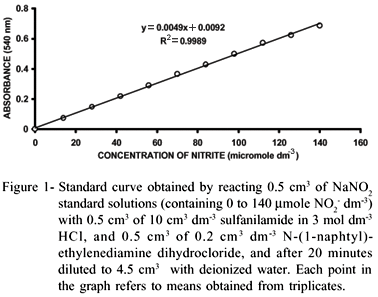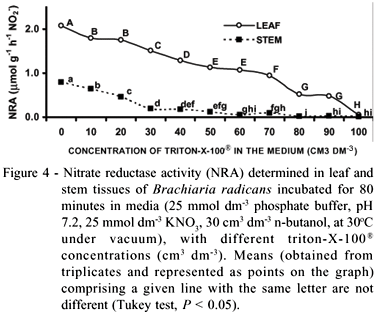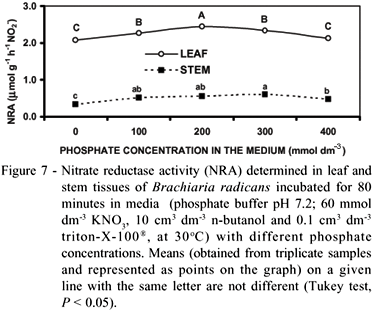Tanner grass (Brachiaria radicans Napper) is a forage plant that is adapted to well-drained soils or wetlands, and responds well to nitrogen (N) fertilization. The assimilation of N involves the nitrate reductase (NR) enzyme, and its activity seems to be dependent on N supply. Molybdenum (Mo) is also important because it is a cofactor of NR. In this study, the variables of an in vivo assay were optimized for measuring nitrate reductase activity (NRA) in the leaves and stem tissues. This method was used to evaluate NO3- metabolism in plants fertilized with NaNO3, NH4Cl or urea, in association with or without application of H2MoO4, aiming to provide guidelines for N management of this species. The best conditions to determine NRA involved the incubation of 300 mg of tissues in a medium composed of 200 mmol dm3 phosphate buffer (pH 7.4), 60 mmol dm3 KNO3, 10 cm³ dm3 n-butanol, 0.1 cm³ dm3 detergent (triton-X-100®), under vacuum and in the dark for a period of 60 to 100 minutes. Leaves showed NRA levels two to three times higher than stems. Although there were some interactions between treatments, stem fresh weight and NRA were not affected by N sources. Plants fertilized with NaNO3 showed the best growth and NRA values when compared with NH4Cl and urea, which had, respectively, the lowest and intermediate scores. The application of Mo in the absence of N improved NRA and did not affect leaf and stalk growth. In the presence of N, the Mo levels applied limited leaf NRA and plant development.
Brachiaria arrecta; nitrogen; molybdenum; enzyme













